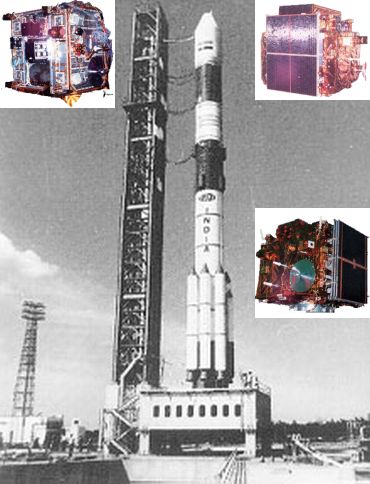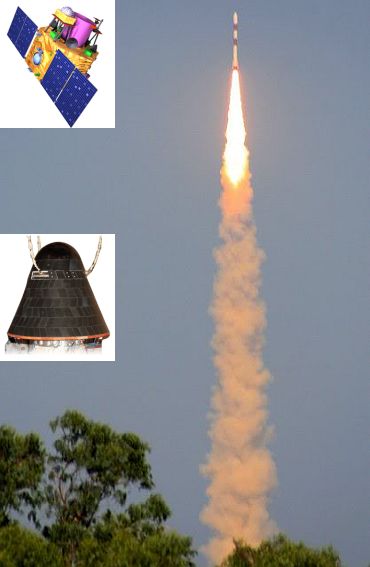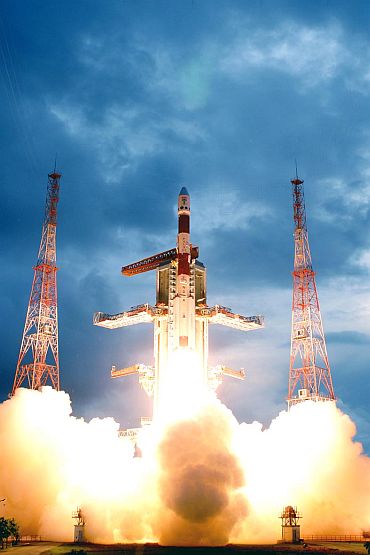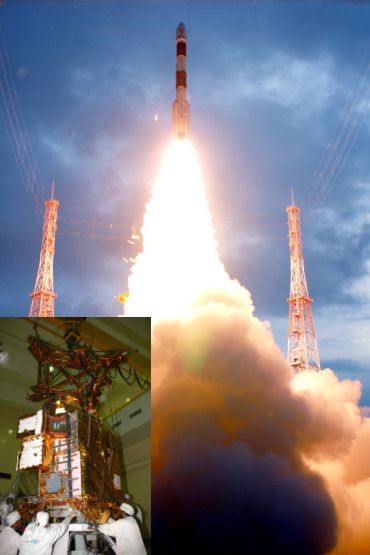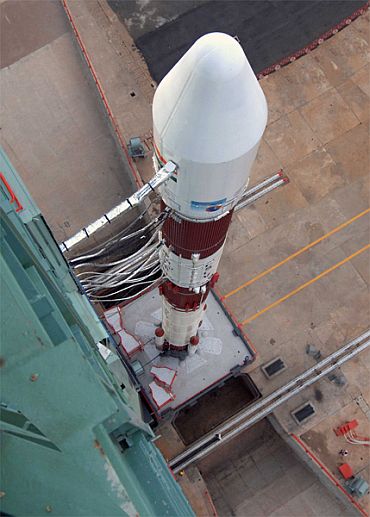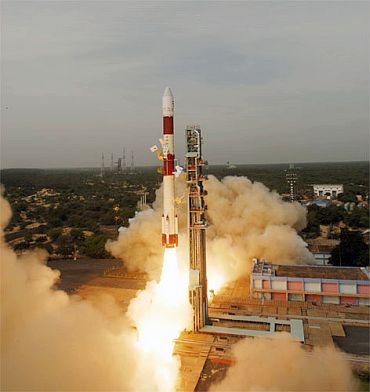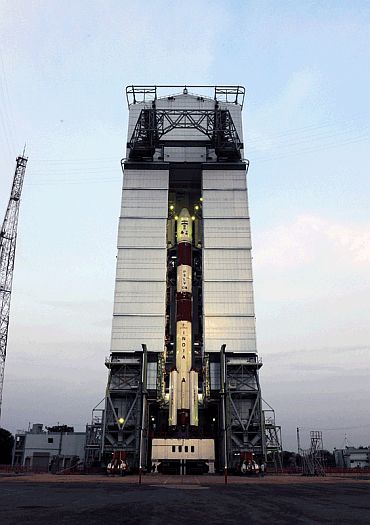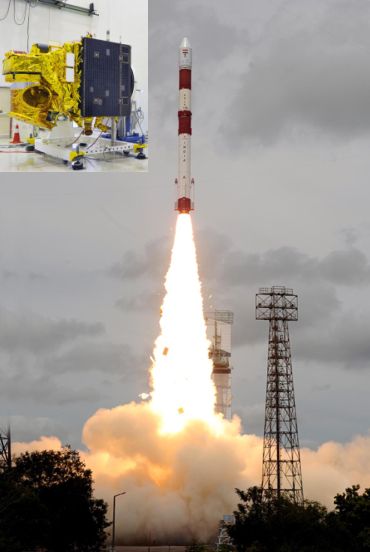 | « Back to article | Print this article |
In PHOTOS: PSLV, India's trusted satellite launcher
The placing of four satellites into orbit on October 12, 2011 is yet another milestone in the glorious career of Indian Space Research Organisation's trusted Polar Satellite Launch Vehicle.
With 19 successful launches, the reliability rate of the PSLV has been superb. With its variant configurations, PSLV has proved its multi-payload, multi-mission capability in a single launch and its geosynchronous launch capability.
Let's take a look at the achievements of ISRO's trusted workhorse.
Click on NEXT to read further...
In PHOTOS: PSLV, India's trusted satellite launcher
PSLV D-1
Mission Date: September 20, 1993,
Payload: First developmental launch of the PSLV with IRS-1E (Remote sensing of the earth for natural resources management applications) on board
Status: Unsuccessful as the rocket failed.
PSLV D-2
Mission Date: October 15, 1994
Payload: The second launch of the PSLV with IRS-P2 satellite (for earth mapping).
Status: Successful
PSLV D-3
Mission Date: March 21, 1996
Payload: IRS-P3 carried two remote sensing payloads. It also carried an X-ray astronomy payload.
Status: Successful
Click on NEXT to go further...
In PHOTOS: PSLV, India's trusted satellite launcher
PSLV C-1
Mission Date: September 29, 1997
Payload: IRS-D, a follow on satellite to IRS-C, belonged to the second generation of IRS series of satellites. It had similar capabilities as IRC-C in terms of spatial resolution, spectral bands, stereoscopic imaging, wide field coverage and revisit capability. Improvements were carried out in the IRS-D satellite taking into account the IRS-C experiences and that resulted in better quality imageries.
Status: Successful
PSLV C-2
Mission Date: May 26, 1999
Payload: OCEANSAT (IRS-P4, first satellite primarily built for ocean applications) , KITSAT-3 (to develop and perform the in-orbit test of an indigenous satellite system) and DLR-TUBSAT (for high resolution earth observation tasks)
Status: Successful
Click on NEXT to read further...
In PHOTOS: PSLV, India's trusted satellite launcher
PSLV C-3
Mission Date: October 22, 2001
Payload: Technology Experiment Satellite, weighing 1108 kg, to demonstrate and validate the technologies like attitude and orbit control system, high-torque reaction wheels, new reaction control system, light-weight spacecraft structure, solid state recorder, X-band phased array antenna, improved satellite positioning system, miniaturised TTC and power systems and, two-mirror-on-axis camera optics
Status: Successful
PSLV C-4
Mission Date: September 12, 2002
Payload: METSAT (renamed as Kalpana - 1 on February 5, 2003 after the Indian born American Astronaut Dr Kalpana Chawla, who died on February 1, 2003 in the US Space Shuttle Columbia disaster) was the first in the series of exclusive meteorological satellites built by ISRO
Status: Successful
Click on NEXT to go further...
In PHOTOS: PSLV, India's trusted satellite launcher
PSLV C-5
Mission Date: October 17, 2003
Payload: RESOURCESAT-1 (earth observation satellite) was the tenth ISRO satellite in the IRS series, intended to not only continue the remote sensing data services provided by IRS-1C and IRS-1D
Status: Successful
PSLV C-6
Mission Date: May 5, 2005
Payload: CARTOSAT-1 (first Indian Remote Sensing Satellite capable of providing in-orbit stereo images) and HAMSAT (Micro-satellite for providing satellite based Amateur Radio services to the national as well as the international community of Amateur Radio Operators)
Status: Successful
Click on NEXT to go further...
In PHOTOS: PSLV, India's trusted satellite launcher
PSLV C-7
Mission Date: January 10, 2007
Payload: CARTOSAT-2 (With a state-of-the-art panchromatic camera that take black and white pictures of the earth in the visible region of the electromagnetic spectrum), SRE-1 (intended to demonstrate the technology of an orbiting platform for performing experiments in micro gravity conditions). It also helped lauch several foreign satellites: LAPAN-TUBSAT (Indonesia's first remote sensing satellite, made by the experts from National Institute of Aeronautics and Space (Lembaga Penerbangan dan Antariksa Nasional, Japan) and Technical University Berlin (TUB) Germany) and PEHUENSAT-1 (an Argentinan nanosatellite for educational, technological and scientific mission)
Status: Successful
PSLV C-8
Mission Date: April 23, 2007
Payload: 352 kg AGILE (an X-ray and Gamma ray astronomical satellite for the Italian Space Agency).
Status: Successful
Click on NEXT to go further...
In PHOTOS: PSLV, India's trusted satellite launcher
PSLV C-9
Mission Date: April 28, 2008
Payload: PSLV launched ten payloads - CARTOSAT-2A (Imageries from this satellite are used for cartographic applications like mapping, urban and rural infrastructure development and management, as well as application in Land Information (LIS) and Geographical Information System); Indian Mini Satellite (a low-cost microsatellite imaging mission of ISRO); and eight nanosatellites from abroad together weighing about 50 kg.
Status: Successful
PSLV C-10
Mission Date: January 23, 2008
Payload: Launched TECSAR (which gives India the ability to monitor cross-border movements of suspected terrorists, as well as troop movements in Pakistan and other neighbouring countries, at night and under all weather conditions. The satellite was reportedly a modified TECSAR satellite, purchased from Israel Aerospace Industries for $200 million)
Status: Successful
Click on NEXT to go further...
In PHOTOS: PSLV, India's trusted satellite launcher
PSLV C-11
Mission Date: October 22, 2008
Payload: Chandrayaan-1, India's first mission to Moon. The spacecraft orbited around the moon at a height of 100 km from the lunar surface for chemical, mineralogical and photo-geologic mapping of the moon. The spacecraft carried 11 scientific instruments built in India, USA, UK, Germany, Sweden and Bulgaria.
Status: Successful
PSLV C-12
Mission Date: April 20, 2009
Payload: RISAT-2 (Radar Imaging Satellite with all weather capability to take images of the earth) and ANUSAT (Anna University Satellite was the first satellite built by an Indian University under the overall guidance of ISRO)
Status: Successful
Click on NEXT to go further...
In PHOTOS: PSLV, India's trusted satellite launcher
PSLV C-14
Mission Date: September 23, 2009
Payload: OCEANSAT-2 (to study surface winds and ocean surface strata, observation of chlorophyll concentrations, monitoring of phytoplankton blooms, study of atmospheric aerosols and suspended sediments in the water) and six nano-satellites (four CUBESATs were educational satellites from European universities, each weighing around one kg. Two other spacecrafts Rubin-9.1 and Rubin-9.2 weighing 8kg each primarily used for the Automatic Identification System for maritime applications)
Status: Successful
Click on NEXT to go further...
In PHOTOS: PSLV, India's trusted satellite launcher
PSLV C-15
Mission Date: July 12, 2010
Payload: CARTOSAT-2B (capable of imaging a geographical strip of 9.6 km with a resolution of better than 1 metre), ALSAT-2A (Algerian remote sensing satellite), NLS 6.1 (Built by Space Flight Laboratory of the University of Toronto, Canada for testing various satellite technologies) and 6.2 (built by University of Applied Sciences of Switzerland for testing various satellite technologies) and STUDSAT (First pico-satellite developed in the country by a consortium of sven engineering colleges from Karnataka and Andhra Pradesh. Weighing less than 1 kg, STUDSAT's primary objective was promoting space technology in educational institutions and encourage research and development in miniaturised satellites)
Status: Successful
Click on NEXT to go further...
In PHOTOS: PSLV, India's trusted satellite launcher
PSLV C-16
Mission Date: April 20, 2011
Payload: Three satellites with a total payload mass of 1404 kg -- RESOURCESAT-2 (intended to continue the remote sensing data services to global users provided by RESOURCESAT-1), YOUTHSAT (a joint Indo-Russian stellar and atmospheric satellite mission with the participation of students from universities at graduate, post graduate and research scholar level) and X-SAT (Singapore's first satellite intended to demonstrate technologies related to satellite based remote sensing and onboard image processing)
Status: Successful
Click on NEXT to go further...
In PHOTOS: PSLV, India's trusted satellite launcher
PSLV C-17
Mission Date: July 15, 2011
Payload: GSAT-12, configured to carry 12 Extended C-band transponders to meet the country's growing demand for transponders in a short turn-around-time. The 12 Extended C-band transponders augmented the capacity in the INSAT system for various communication services like tele-education, telemedicine and village resource centres
Status: Successful
Click on NEXT to go further...
In PHOTOS: PSLV, India's trusted satellite launcher
PSLV C-18
Mission Date: October 12, 2011
Payload: Megha-Tropiques (an Indo-French Joint Satellite Mission for studying the water cycle and energy exchanges in the tropics. The main objective of this mission is to understand the life cycle of convective systems that influence the tropical weather and climate and their role in associated energy and moisture budget of the atmosphere in tropical regions); SRM-SAT (developed by the students and faculty of SRM University attempts to address the problem of global warming and pollution levels in the atmosphere by monitoring carbon dioxide and water vapour); VESSELSAT-1 (A microsatellite developed and built by LuxSpace of Luxembourg, which carries the Automatic Identification System for ships to detect signals automatically transmitted by vessels at sea in the region covered by the satellite footprint); and JUGNU (designed and developed by Indian Institute of Technology, Kanpur under the guidance of ISRO. The satellite is intended to prove the indigenously developed camera system for imaging the earth in the near infrared region and test image processing algorithms)
Status: Successful
Click on MORE to see another feature...

